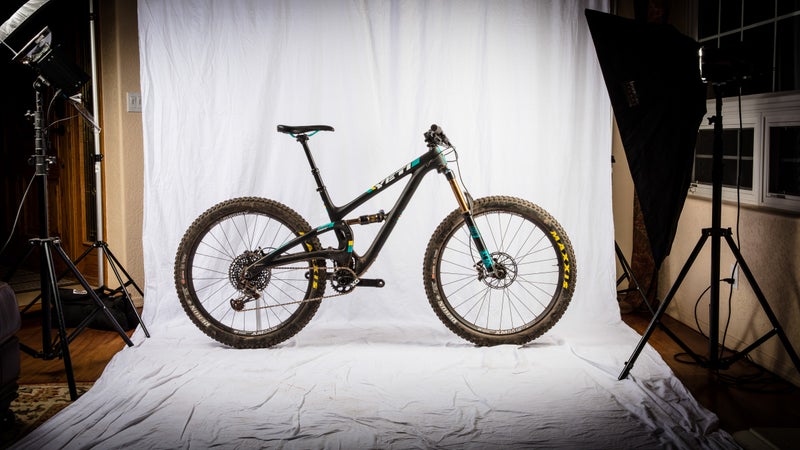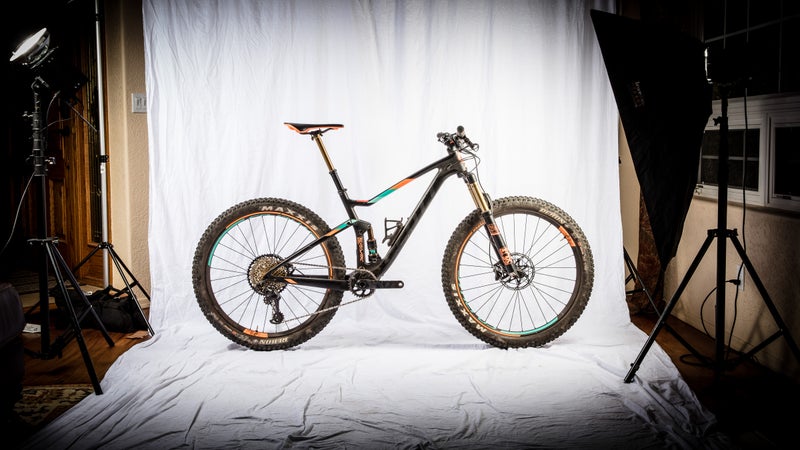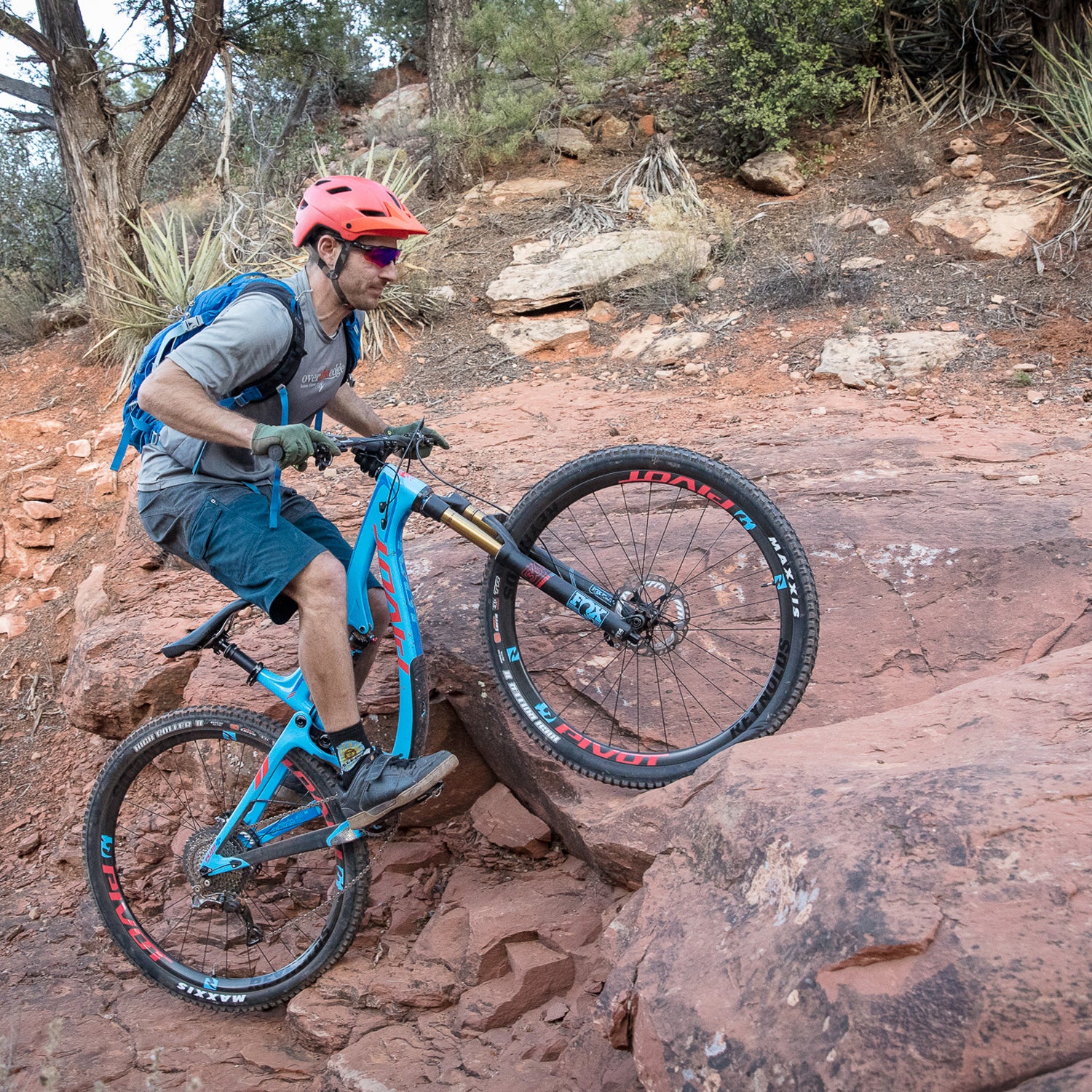Buying tires for your car can be confounding. What do all those numbers and letters mean? Do I need an all-terrain tire, or am I better off with an all-season? It’s a giant rabbit hole, and one that now exists in the mountain bike world, too. There are 26-, 29-, and 27.5-inch models (sometimes still called 650B) and an ever-growing number of tire widths, including “plus,” where manufacturers put wider, higher-volume tires on existing rims for additional benefits.
“Plus tires add traction and mute the small bumps,” says Chris Conroy, president of Yeti Cycles, speaking about the company’s SB5+. “These are bikes for any rider who wants added confidence, a supple ride, and all-day performance.” The added traction, confidence, and compliance come from the larger rubber patch contacting the ground.
There are drawbacks, of course. For one, the bigger tires add weight and rolling resistance, which can make for a slower, heavier-feeling ride. (In the case of bikes that accommodate both 27.5+ and 29-inch wheels, I’ve found the that the weights are either comparable, or, in a few cases, the 29ers are nominally lighter.) Plus tires can also be extremely pressure sensitive: Get the combination just right and they feel bomber. Go a PSI or two low and the larger sidewalls and added volume can wiggle, feel unstable in corners, and pinch-flat easily. Low bottom brackets, which you often find on plus-size bikes, have also caused pedal-strike issues.
Plus development is taking place on both 27.5- and 29-inch wheels. While the innovations around 29+ have resulted in some of my favorite bikes out there (Trek Stache, Salsa Deadwood Sus, and Niner Ros9+), most of today’s plus models are 27.5+. The tires generally measure 2.8 to 3 inches. On a 29er rim (622mm), you get 30 inches and up of total wheel diameter, which is wildly too big to fit existing frame designs. On the other hand, on a standard 27.5-inch rim (584mm), three-inch rubber bumps the overall wheel size to around 28 inches, which either requires minimal changes to existing bike geometries or fits just fine. Valid arguments about the deftness and weight of 29+ exist, but 27.5+ bikes are more popular because engineering them is easier.
One of the most common questions I hear is, “Are plus bikes right for me?” The truth is, there’s no exact answer. Mostly, my experience is that plus wheels reward those who like a more stable-feeling ride. On the other side, skinnier tires favor speed, handling, and agility. “[A plus-size tire] gives you so much traction and so much confidence,” says Chris Cocalis, owner of Pivot Cycles, whose Switchblade, which allows for both 27.5+ and 29-inch wheels, was my favorite test bike of the year. “The technology can allow a high-level expert rider to push harder in the right conditions, especially as tire performance and impact resistance improve without adding weight. But it can also up the confidence and level of riding for every rider.”
If you live somewhere with a lot of loose terrain—for instance, the jangling rocks in Tucson and Phoenix or the gravelly kitty litter in Los Alamos, New Mexico—plus tires will make a difference. But if you live somewhere with a lot of smooth, flowing, not highly technical trails—like Bend, Oregon—I’d likely lean away from plus-size bikes. The small-bump compression and added traction of plus tires won’t be as noticeable or important in such settings, but you will notice the increased rolling resistance. Also, I’ve noticed that smaller riders, as well as women, often lean away from plus-size and toward 29ers because their smaller statures tend to be more affected by the added weight and rolling resistance of the wider tires.
Going forward, plus bikes will continue to evolve. Current thinking calls anything that’s 2.4 inches and under “standard” and 2.8- to 3.25-inch “plus,” but the coming season is going to see a profusion of tires that split the difference. The idea, of course, is that the in-between width adds traction without the weight of a full plus-size tire.
This constantly shifting landscape can be aggravating. And the truth is that when we get into this game of a tenth or two of an inch, it’s likely splitting hairs. The only silver lining: The industry continues to refine designs, which, in the long run, will mean better bikes and more choices.
If you’re looking to buy a plus-size bike, here’s a smattering of our favorite models from 2017 and thoughts on why they might be right for you. As always, the best way to find the right bike is to demo several and find the one that feels good.
Pivot Switchblade ($5,200 to $10,300)

There are two types of plus-size bikes today: those marketed solely around plus-wheels, and those intended to fit both 27.5+ and 29. Along with the Santa Cruz Tallboy, the carbon was the best at morphing between sizes during this year’s bike test.
With a DW-Link rear suspension that pedals admirably, incredibly refined cable routings and ports, and a graphics package that made testers swoon, this bike is possibly the most refined model I’ve ever seen from Pivot. The Switchblade has 135mm of rear travel and an even bigger front end—150mm in 29 mode, 160mm for 27.5+. But what really sets it apart is a proprietary rear hub spacing that Pivot calls (tongue in cheek) Super Boost 157. Without getting into the wonky details, there are two things of note: The first is that a 157mm rear end is not new. It’s been used on the downhill circuit. Also, the additional width (as with the Boost 148 before it) makes for an incredibly stiff wheel and platform and provides for huge tire clearance (up to 3.25 inches on a 27.5 wheel), while maintaining relatively short chainstays. It also makes it possible to run a front derailleur. It works great and makes good sense, but the singularity (you can’t sub your old wheels) was a strike against it in some testers’ eyes.
The Switchblade feels as burly as a , but one that’s souped up with a drag-race engine. This bike jammed through rock gardens, carved corners like a turkey knife, and basically shrugged off everything we threw at it. At 28.9 pounds, it is not exceptionally light, but it never felt heavy.
To account for the slight wheel-size difference that’s created when you swap, Pivot included a headset spacer that raises the bottom bracket on the plus setup. It works so well that we had almost zero of the pedal-strike issues that have plagued some earlier 27.5+ models. For most long days and all-around riding, I picked the 29-inch hoops with 2.4-inch tires. However, on loose, rubbly terrain, the combo of 2.8-inch Ikon+ tires on 27.5 wheels was the clear winner. The fact that I couldn’t decide outright on wheel preference basically underscores the Switchblade’s utility. It’s an incredible trail bike in both iterations—and the option to run either wheel size makes it great for dipping your toes in both ends.
Yeti SB5+ ($4,700 to $10,500)

By the numbers, the Yeti and Pivot are basically identical, yet they feel and ride very differently. With 127mm of rear travel and a 150mm fork, the has a harder edge to it than the Switchblade and feels more aggressive and racy. It’s significantly lighter, too—just 27.1 pounds, even with a lower-tier build.
The bike uses Yeti’s proprietary, tried-and-true Switch Infinity Link, which has earned kudos since its introduction a few years back for its full, even feel through the range of travel. On some other Yeti models, I’ve felt that the suspension was almost too progressive and was never able to ramp it up all the way. Not so here: The SB5+ has the most supple and consistent-feeling suspension we’ve ever experienced from Yeti. It was even a huge hit with the women who tested it, meaning not too stiff for their generally lighter weights.
One of the hardest things to accomplish on a plus-size bike is accommodating for the extra rubber while keeping the rear triangle tight. A handful of companies have gone the elevated chainstay route, and though this can often look goofy verging on atrocious, Yeti nailed it with the SB5+. This bike is so gorgeously sculpted and tight that you barely even notice the squat rear triangle.
Yeti bikes are pricey, but I appreciate that even the lowest-level offerings come equipped with the same suspension as the top builds. So, for $4,700, you get the same Fox Float shock and 34 Fork that you would find on the $10K model. And there’s not a comedown part on the SLX-XT build package, either—sure the components and wheels are heavier, but Yeti has still chosen quality parts. That makes this a highly confident, all-around trail machine at a solid value for those looking for a plus-size daily driver. Don’t tell Yeti, but we hear the bike rides exceptionally well with 29-inch wheels, too.
Scott Spark Plus Tuned ($2,700 to $8,000)

�±�’v�� already written about the , but it’s worth revisiting because this bike is so quick, deft, lively, and—yes—light, at 26 pounds for a size medium. That’s exceptionally feathery for a bike with 120mm of rear travel and a 130mm Fox 34 fork, especially one with 2.8-inch tires.
The Spark Plus is also a very different machine than the others. If the Pivot is the monster truck of the bunch, and the Yeti is the Range Rover, the Scott is like the Subaru Outback, albeit with the 3.6-liter, six-cylinder engine. It’s fast and peppy and leans more to the cross-country side of things, and not a single tester who rode it said anything about slow or heavy or rolling resistance. Obviously, it’s no race bike, but the race pedigree is here, and for the average rider on the average trails, the Spark Plus is plenty of bike. Scott also says the bike rides great with 29-inch wheels.
I also like that Scott is offering the Spark Plus at more affordable price points so a wider audience can check out the plus trend. One warning: Due to the heavier wheels and components, the base model 730 will suffer from some of the complaints that people tend to level at plus bikes, namely that they are ponderous and slow. At $2,700, it’s a great buy and will certainly get the job done. But the alloy 720, with SRAM GX1 parts for $3,700, and the carbon 710 at $5,000 for an XT build, represent the true convergence of high-quality parts and build plus excellent value.


